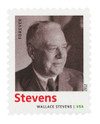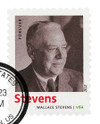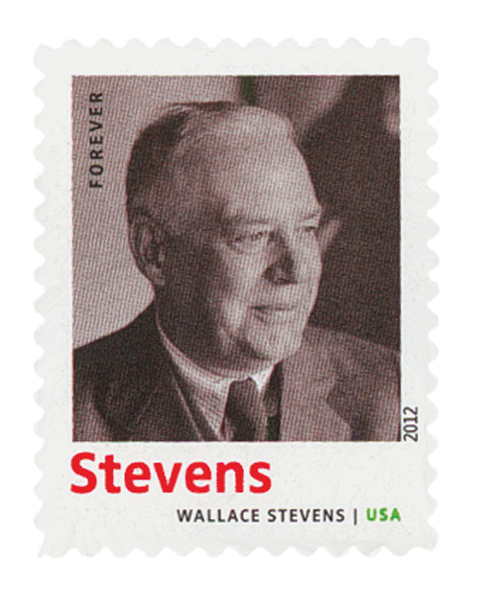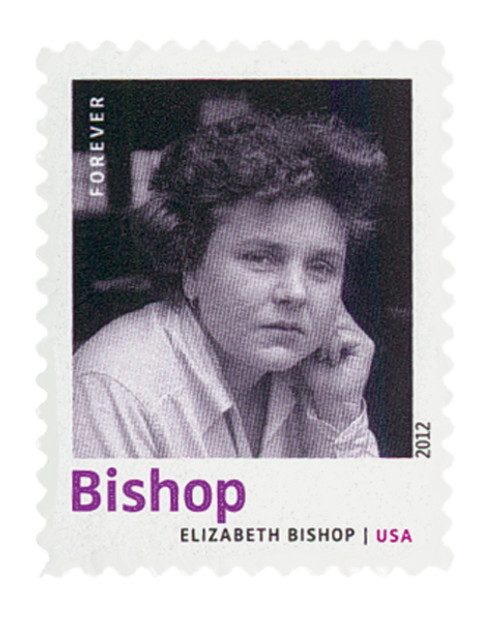
# 4660 - 2012 First-Class Forever Stamp - 20th Century American Poets: Wallace Stevens
20th Century American Poet
Issue Date: April 21, 2012
City: Los Angeles, CA
Quantity: 2,000,000
Printed By: Ashton Potter
Printing Method: Offset
Perforations: Die cut 10 ¾ x 11
Color: multicolored
Birth Of Wallace Stevens
The son of a successful lawyer, Stevens grew up in a wealthy household with an extensive in-home library. He went on to attend Harvard, where he wrote for both of the university’s publications and earned all of the school’s writing honors.
Stevens was unable to graduate because the family didn’t have the money, so he moved to New York City where he worked as a journalist. Though he enjoyed writing, his father pushed him to attend law school as his brothers before him had done. So he abandoned writing to attend New York Law School.
After getting married, Stevens settled in New York and worked for several different law firms before being hired by the American Bonding Company in 1908. He worked there until he was made vice president of the New York office of Equitable Surety Company in 1914. And in 1916, the Hartford Accident and Indemnity Company in Hartford, Connecticut hired him. He would remain at that company for the rest of his life, being promoted to vice president in 1934.
Stevens had quit writing for several years, but wrote his first poems as an adult in 1914 and had them published in Trend. In 1915, he wrote some of his first significant poems, “Peter Quince at the Clavier” and “Sunday Morning.” He also wrote the prize-winning play, Three Travelers Watch a Sunrise.

By 1923, Stevens finished his first book of poems, Harmonium. While it received some praise from editor Harriet Monroe, it was largely ignored by the critics of the day. Stevens would take a break from writing for several years due to the birth of his daughter, but he began writing regularly again in 1933.
Stevens published his second collection, Ideas of Order, in 1935. This collection earned him more attention and praise as a unique poet of the time. However, some of his reviews were more negative, complaining that his “art-for-art’s sake” tone was inappropriate for a world in the midst of a Depression. But Stevens believed that the world was improving and was dedicated to interpreting the world as he wanted. Much of his poetry in the coming years would be about poetry and the role it played in the world.
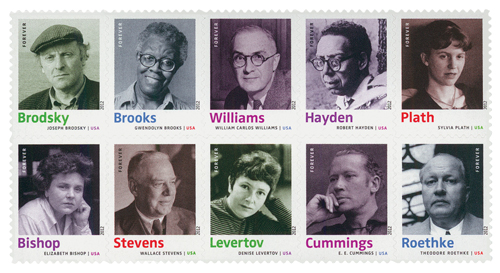
Much of Stevens’ writing was concerned with the transformative power of the imagination. Perhaps one of the most common themes in his writing was the idea of the “supreme fiction.” Stevens believed God was a human creation, yet people still needed to believe in a larger force, which he called the supreme fiction. Stevens once confessed he found writing to be both absurd and fulfilling. Yet it was through his writing that he explored profound and lasting ideas that earned him praise late in his career.
Stevens published his final collection in 1950, and by this time was considered one of the greatest poets of the day. Literary critic Harold Bloom considered Stevens the “best and most representative” American poet of his era. In the 1950s he earned several awards, including the Bollingen Prize for Poetry, the 1951 National Book Award, and the 1955 Pulitzer Prize for Poetry.
Stevens suffered from stomach cancer in his later years and died on August 2, 1955, in Hartford, Connecticut.
Click here to read some of Stevens’ poems.
20th Century American Poet
Issue Date: April 21, 2012
City: Los Angeles, CA
Quantity: 2,000,000
Printed By: Ashton Potter
Printing Method: Offset
Perforations: Die cut 10 ¾ x 11
Color: multicolored
Birth Of Wallace Stevens
The son of a successful lawyer, Stevens grew up in a wealthy household with an extensive in-home library. He went on to attend Harvard, where he wrote for both of the university’s publications and earned all of the school’s writing honors.
Stevens was unable to graduate because the family didn’t have the money, so he moved to New York City where he worked as a journalist. Though he enjoyed writing, his father pushed him to attend law school as his brothers before him had done. So he abandoned writing to attend New York Law School.
After getting married, Stevens settled in New York and worked for several different law firms before being hired by the American Bonding Company in 1908. He worked there until he was made vice president of the New York office of Equitable Surety Company in 1914. And in 1916, the Hartford Accident and Indemnity Company in Hartford, Connecticut hired him. He would remain at that company for the rest of his life, being promoted to vice president in 1934.
Stevens had quit writing for several years, but wrote his first poems as an adult in 1914 and had them published in Trend. In 1915, he wrote some of his first significant poems, “Peter Quince at the Clavier” and “Sunday Morning.” He also wrote the prize-winning play, Three Travelers Watch a Sunrise.

By 1923, Stevens finished his first book of poems, Harmonium. While it received some praise from editor Harriet Monroe, it was largely ignored by the critics of the day. Stevens would take a break from writing for several years due to the birth of his daughter, but he began writing regularly again in 1933.
Stevens published his second collection, Ideas of Order, in 1935. This collection earned him more attention and praise as a unique poet of the time. However, some of his reviews were more negative, complaining that his “art-for-art’s sake” tone was inappropriate for a world in the midst of a Depression. But Stevens believed that the world was improving and was dedicated to interpreting the world as he wanted. Much of his poetry in the coming years would be about poetry and the role it played in the world.

Much of Stevens’ writing was concerned with the transformative power of the imagination. Perhaps one of the most common themes in his writing was the idea of the “supreme fiction.” Stevens believed God was a human creation, yet people still needed to believe in a larger force, which he called the supreme fiction. Stevens once confessed he found writing to be both absurd and fulfilling. Yet it was through his writing that he explored profound and lasting ideas that earned him praise late in his career.
Stevens published his final collection in 1950, and by this time was considered one of the greatest poets of the day. Literary critic Harold Bloom considered Stevens the “best and most representative” American poet of his era. In the 1950s he earned several awards, including the Bollingen Prize for Poetry, the 1951 National Book Award, and the 1955 Pulitzer Prize for Poetry.
Stevens suffered from stomach cancer in his later years and died on August 2, 1955, in Hartford, Connecticut.
Click here to read some of Stevens’ poems.




